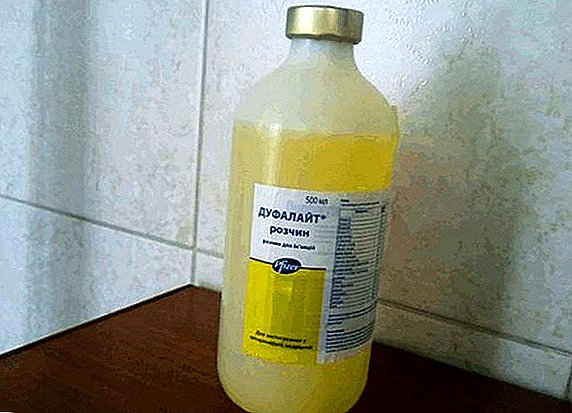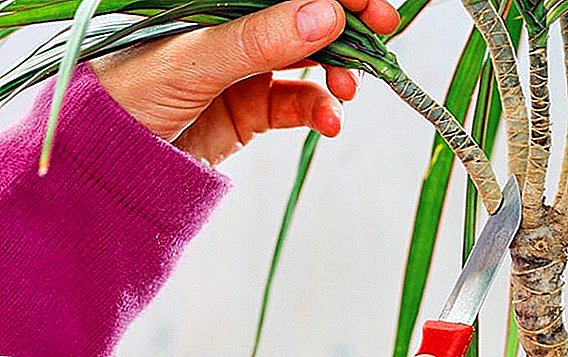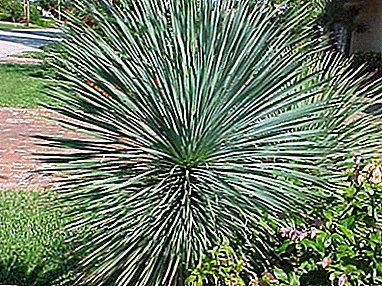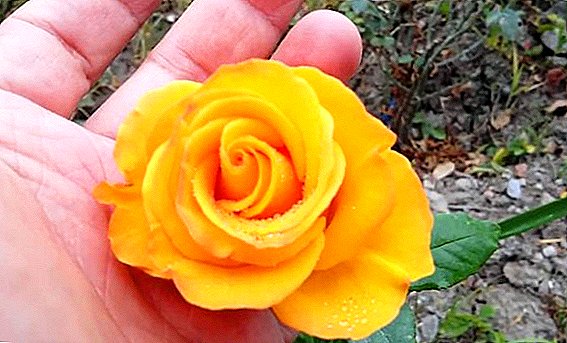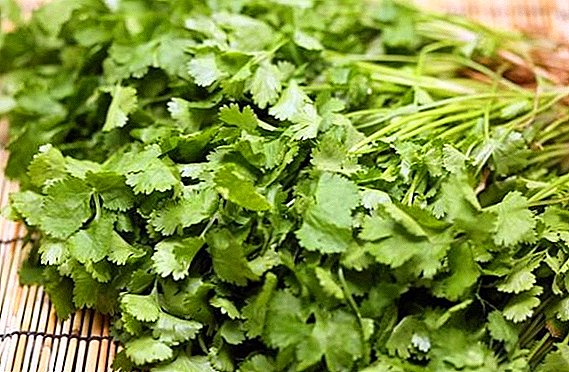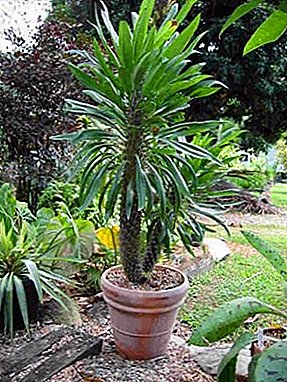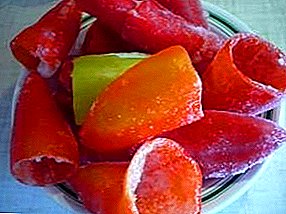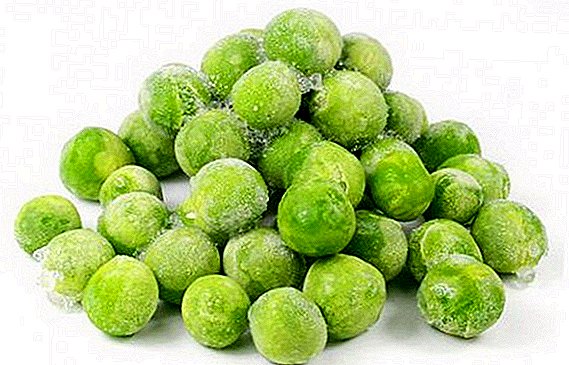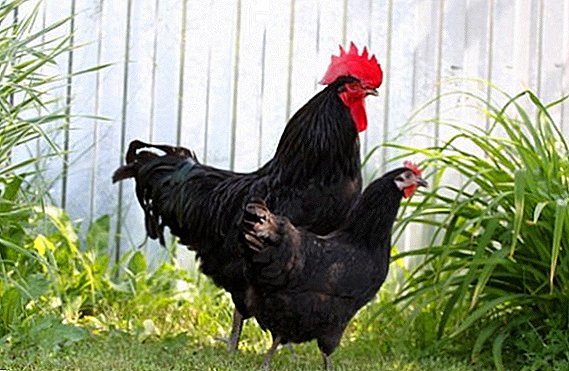 The chicken was the first bird domesticated by man, but few know that this process began in Asia, according to some sources in China. The Middle Kingdom today is not only the world leader in the production and consumption of chicken meat, but also the "supplier" of quite interesting breeds of this bird. One of these achievements of Chinese breeding is a breed with a slightly funny name for our ear - Xin Xin Dian. "
The chicken was the first bird domesticated by man, but few know that this process began in Asia, according to some sources in China. The Middle Kingdom today is not only the world leader in the production and consumption of chicken meat, but also the "supplier" of quite interesting breeds of this bird. One of these achievements of Chinese breeding is a breed with a slightly funny name for our ear - Xin Xin Dian. "
The history of the appearance of the Chinese breed
The Chinese are a secretive people and are not in a hurry to share the details of their achievements. The only thing known about the breed is that it is a cross (hybrid), which is the result of the painstaking work of the breeders of the Shanghai Poultry Institute, who tried to achieve the solution of three tasks at once:
- increase egg production rates;
- increase the size of the egg, not enlarging the chicken itself, but, on the contrary, reducing its weight;
- accelerate the ripening process (get the earliest onset of egg production as early as possible).
Did you know? There is a version that Xin Xin Dian It turned out as a result of a not-so-successful attempt to bring out a new breed of fighting cockerels (the resulting hybrid did not respond to the nature of the task). So that the works of breeders were not in vain, it was decided to “convert” the new breed into an egg one. The calculation is simple: there are already plenty of meat chickens in the Middle Kingdom, and the Chinese do not recognize the meat-egg direction.Lakedanzi, also known as Uheilyuy, was probably used as parent material.

In the 80s of the last century, the chickens that met the stated requirements were finally obtained, and the initial characteristics in the breed were consolidated, thanks to which it was officially registered with the Ministry of Agriculture of the People's Republic of China, received its own trademark and was recommended for breeding “in itself”, that is, to maintain cross-breeding every time there is no need for interbreeding, it is enough mating of the birds of this breed among themselves.
A new Chinese breed has entered the territory of Russia relatively recently. In 2012, it was brought in eggs by amateur enthusiast Nikolai Roshchin, a resident of the Black River (a small village near Khabarovsk), who owns today more than a thousand chickens of the rarest breeds.
Since then, the Chinese hen has managed to settle down and be loved by the people of Russia and nearby countries, and even get affectionate nickname "blue".
Video: description of the breed of chickens Xin Xin Dian
Breed description
Xin Xin Dian have a rather attractive appearance, but the most interesting in them, perhaps, is the color of eggs. They are not white or cream, but greenish-turquoise or blue. Farmers note that the lighter the eggs become to the completion of the egg-laying, the color leaves especially fast with frequent (daily) egg production.
Check out the description and the nuances of the content of such egg species as Grunleger, Siberian pedal-throat, leggorn, broken Brown, Italian quail, shaver and minor.
For unknown reasons, the eggshell darkens as the chickens age, and this feature does not depend on the diet or the conditions of the poultry. But back to the description of adult birds from China. 
Appearance
Xin Xin Dian - a bird of small size, the mass of males does not exceed 2 kg, layers - 1.5 kg. The build of chickens is consistent with their egg orientation: light bones, skinny body with a nearly horizontal fit (in the form of a trapezoid), rounded chest, straight back, strong belly (in layers), well-developed wings of medium size, tightly pressed to the body.
Important! Inside the breed there are three independent directions - black, copper and yellow (in our case black Xin Xin Dyani). To preserve the original qualities of the hybrid, they should be kept separate and not crossed with each other, this significantly reduces productivity.
The head and neck are medium in size, birds of both sexes have a crest, the cock is large (the bigger, the better), but compact, leaf-shaped and bright red. Cocks have the same color (they should also be long) in cocks, their lobes and muzzle, in chickens they are gray or bluish.  The eyes are bright orange. The beak is short, gray (black for black birds, with yellow for light patches). Both cockerels and layers Xin Xin Dian boast lush, high-set tails in the shape of an inverted rainbow.
The eyes are bright orange. The beak is short, gray (black for black birds, with yellow for light patches). Both cockerels and layers Xin Xin Dian boast lush, high-set tails in the shape of an inverted rainbow.
Large round feathers in the tail, distinguishing the rooster from the hen (kositsy), are poorly developed. The paws are short, without feathers, gray or yellow-gray, the skin of a bird has the same shade.
In leggard hens, the eggs are colored turquoise, the Laceedani are green, the Aracuan and Ameraukan breeds are blue, and the maranov eggs are chocolate-colored.
Character
As befits the hens of the egg breeds, "blue" is distinguished by high activity. They are light and mobile, and, unlike many of their relatives, they fly very well. Farmers cannot enjoy the excellent stress tolerance of the Chinese breed and its ability to easily adapt to the proposed living conditions.  For broods, discipline, accuracy, and adherence are typical: for the night, they always perch on the roost, and eggs are laid exclusively in the nests intended for this purpose. At the same time, both roosters and chickens are rather calm and almost do not show aggression, the exceptions are only ordinary showdowns of relations between the young representatives of the stronger sex.
For broods, discipline, accuracy, and adherence are typical: for the night, they always perch on the roost, and eggs are laid exclusively in the nests intended for this purpose. At the same time, both roosters and chickens are rather calm and almost do not show aggression, the exceptions are only ordinary showdowns of relations between the young representatives of the stronger sex.
Puberty and egg production
As planned, puberty in chickens Xin Xin Dian occurs very early. The first laying of the hen carries out already in the fourth month of life. The egg production figures are impressive: on average, one layer produces 250 eggs weighing 55-60 g per year.
A distinctive feature of Chinese chickens are the nutritional properties of their eggs. This product is particularly rich in vitamins, minerals and fatty acids, thereby helping to strengthen the immune system, restore the "shaky" nervous system, normalize hormonal levels.  Xin Xin Dian shows its maximum productivity in the second year of life: during the first year, its eggs are smaller and their number is not so high, and since the third year, egg production begins to decline. Therefore, farmers are encouraged to slaughter three-year-old birds for meat and completely update the flock.
Xin Xin Dian shows its maximum productivity in the second year of life: during the first year, its eggs are smaller and their number is not so high, and since the third year, egg production begins to decline. Therefore, farmers are encouraged to slaughter three-year-old birds for meat and completely update the flock.
Did you know? The common opinion that quail eggs are the safest because they do not contain salmonella is a myth. In fact, these ubiquitous bacteria can be found in the eggs of absolutely any bird. In terms of chemical composition, quail eggs have no advantages over chicken, these products are equally useful.
By the way, to the credit of the breed, it must be said that the taste of its meat is also beyond praise, so some farmers consider the chicken not as an egg, but as a universal one (meat-and-egg direction).  It is also worth noting that the dark blue and marsh eggs in the clutch indicate that we are not "clean" Xin Xin Dian, but its hybrid with other breeds of Chinese chickens. These birds may differ in terms of productivity from the original cross.
It is also worth noting that the dark blue and marsh eggs in the clutch indicate that we are not "clean" Xin Xin Dian, but its hybrid with other breeds of Chinese chickens. These birds may differ in terms of productivity from the original cross.
But the statement that the birds of yellow and copper plumage bear brown eggs, and the blue shell "turns out" only in black layers, has nothing to do with the truth. Does not depend on the color of the shell and the color of the chicken that is inside.
Maternal instinct
In hens of the egg direction, very often there is no incubation instinct; for this, such birds are too active. But Chinese blueprints are rare exceptions.  Poultry farmers note that 60-70% of Xin Xin Dian layers are excellent hens, and therefore, the breed can be used by those who have neither an incubator nor other alternative options (often eggs of irresponsible "cuckoos" are simply placed on other breeds, with more developed maternal instinct).
Poultry farmers note that 60-70% of Xin Xin Dian layers are excellent hens, and therefore, the breed can be used by those who have neither an incubator nor other alternative options (often eggs of irresponsible "cuckoos" are simply placed on other breeds, with more developed maternal instinct).
However, some farmers, especially owners of large farms, still prefer to use an incubator, since natural incubation There are disadvantages:
- the hen doesn’t owe anything to anyone: it sits on the eggs whenever it wants, and does not give any guarantees for the fulfillment of its maternal duties;
- in the cold season, newly hatched chicks may die from the cold, left unattended (in the incubator, where the desired temperature is set, this is excluded);
- it is difficult to predict the number of chickens when it is unknown how many eggs are currently hatching;
- the constant laying of fresh eggs in the nest minimizes the chickens 'exit': only a small fraction of the total number hatches, the rest perish;
- forced removal from the nest of the well-worn "mommy" becomes a serious stress for the chicks.
 Thus, Xin Xin Dian can be used as a hen, and whether or not to use her services, each owner can decide for herself.
Thus, Xin Xin Dian can be used as a hen, and whether or not to use her services, each owner can decide for herself.Did you know? Currently, there are 1,000,330,000 eggs produced worldwide, and the share of Celestial of this amount accounts for at least 40%. The second place is occupied by the United States of America.
Content Features
The blueprints are fairly simple to maintain, it is only important to comply with the standard requirements regarding the arrangement of the chicken coop, temperature and light conditions, cleanliness and hygiene, as well as provide the birds with the right diet.
Nutrition
There are clear rules about what substances and in what quantities should be contained in the feed for chickens.  Certain differences exist only for birds of different purposes. The diet of the hens of this breed must meet the requirements for feeding egg breeds.
Certain differences exist only for birds of different purposes. The diet of the hens of this breed must meet the requirements for feeding egg breeds.
Chickens
In order for a bird to provide maximum egg production, its diet should be present:
- grain, and at least half of its volume must be given to the corn, and the second part to make from a mixture of barley, oats, wheat and other cereals;
- vegetables and fruits (root vegetables, pumpkin, legumes, apples, etc.), as well as greens - at least 40% of the total diet; in winter, if such a balance cannot be observed, it is necessary to include vitamin supplements in the feed;
We advise you to read on how to give bran, meat and bone meal, grass, live food, fish oil and yeast to chickens, and whether it is possible to give bread and foam plastic to chickens.
- protein component - from 3 to 12% in the diet (worms, bugs, small amphibians, waste, offal and trimming meat, bones, fish, and dairy products);
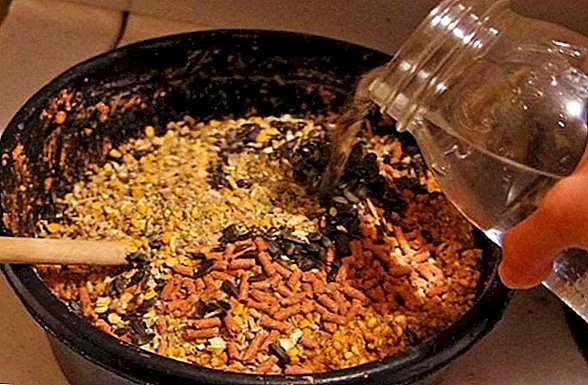
- minerals, especially calcium, necessary for the bird to form the shell - this part of the diet should be formed at the expense of edible chalk, shell rock, meat and bone meal, as well as salt.
Important! Careful Chinese breeders in the "face" of chickens Xin Xin Dian managed to get a bird with a relatively small (in comparison with the overall size) of the stomach. Accordingly, these chickens need less feed than their women with similar dimensions.
Given this feature, it is all the more important to pay attention to a properly balanced diet, which will include the proteins, fats, carbohydrates, vitamins and minerals necessary for a layer.
Video: how to feed the chickens so that they are well carried
Chickens
In the first days of life, the diet of chickens is very different from the nutrition of adult birds, but gradually these differences are smoothed out, and by three months the young are fed the same way as the main herd.
The first meal of the chicks should be offered no earlier than 16 hours after their appearance from the egg. Experience shows that in this case the chickens show much higher rates of survival than when they were fed before.
We recommend reading about how to properly feed chickens from the first days of life.
Usually, boiled egg yolk mixed with semolina is called the initial “baby food”, but recent research suggests that it is better to start with corn flour, and on the fourth day, gradually and in turn add finely chopped greens and crushed boiled vegetables to it , low-fat cottage cheese, baker's yeast. Subsequently, the diet is replenished by special feed for chickens. 
Light mode
In order for the chickens to be well carried, they need a lot of light. In winter, egg production decreases sharply, not only because it becomes cold in the hen house, but also due to a significant reduction in daylight hours. Therefore, when growing egg breeds, such as Xin Xin Dian, it is especially important to organize additional lighting in the hen house.
Important! With proper arrangement of the house on the "usable area" 10-12 m² with a ceiling height of 1.5-2 m will be enough to install two energy-saving lamps with a capacity of 100 watts.The mode of lighting in the house should be organized in such a way that even in winter the daylight lasts at least 12-14 hours.
And in order to minimize energy costs, special attention should be paid to window sizes when building a poultry house: if their area is at least 10% of the floor area, natural lighting will be used most fully. 
Features "housing"
Other features of the arrangement of the house are also associated with the egg orientation of the Chinese chickens. In addition to the standard requirements for cleanliness, dryness, the absence of drafts and at the same time good ventilation, The following indicators are also important for Xin Xin Dian:
- good thermal insulation, especially for cold climatic zones - the blue ones do not tolerate frosts well, so in winter the air temperature in the house should not even approach zero - the permissible minimum is from +5 to + 7 ° С;
- if necessary, in the winter time, heaters should be installed in the house;
It will be interesting to read about how to roost, nest, aviary, walking, chicken coop for poultry.
- compulsory walking in the open air: active Xin Xin Dian feel very badly locked up, when their eggs are drastically reduced in cages; at the same time, walks stop at minus air temperature outside, since such cold for the breed can be dangerous;

- when organizing a courtyard for walking, the fence should be made higher than for other breeds of chickens, and it is even better to cover the upper part of the yard with a net, otherwise the inquisitive birdies, having light weight and strong wings, can easily flip over the fence;
- the area of the house, the size of the perch and feeders must also take into account the restlessness and mobility of the breed: each adult Chinese hen needs at least 3 square meters. m free space in the hen house, at least 40 cm of space on the roost and at least 12 cm of personal area near the feeder;
- to feed the birds and clean the hen house is always desirable at the same time, it calms the disciplined Chinese chickens and sets them to a "blessed way", which has a positive effect on the egg production rates.

Shedding and a break in egg production
The peculiarity of the Chinese chickens is that their egg production is not preserved throughout the season, even if the temperature and light conditions are perfectly organized. Every autumn, the birds begin to molt, replacing the "summer" plumage to a more dense and dense.
Important! Many farmers note that Xin Xin Dian, even during the molting period, does not cease to nest, but the indicators of egg production in this period are still declining.
At this time, the laying hens are completely focused on warming, and taking care of the egg-laying and offspring is completely useless to chickens. Seasonal moulting is a natural process, and you should not panic and be upset about it.
It can last 1.5-2 months. During this period, the bird is most vulnerable to various diseases, therefore, the breeder at this time should pay special attention to its feathered herd: make sure that the house is dry, clean and warm, and also provide the klush with an enhanced diet enriched with vitamins, first of all A, D, B1 and B3. 
Advantages and disadvantages of the breed
For five years, during which the Xin Xin Dian breed is present on the domestic market, she managed to win the love of a large number of farmers.
Breeders point out such breed advantages as:
- high and stable egg production rates, even during the season;
- отменные вкусовые качества яиц и мяса;
- простота и нетребовательность в уходе;
- endurance and a good percentage of chick survival (if the elementary requirements for the content are met, this indicator is at the level of 95-98%);
- early maturity, rapid weight gain (in 60 days young animals gain 700-800 g) and early onset of egg production;
- profitability in the content due to the small size of the stomach of birds;
- calm character and high discipline.
 There are few flaws in the breed.
There are few flaws in the breed.Among them it is worth noting:
- lack of innate ability to adapt to frost, sensitivity to cold and damp;
- high susceptibility to invasive infections;
- relatively short period of high productivity.
Diseases and methods of dealing with them
The main problem for Xin Xin Dian is parasitic infections. Possessing a fairly good immunity, Chinese chickens are still very susceptible to diseases such as trichomoniasis, histomoniasis and coccidiosis, especially with improper care.  In order not to lose the herd, any beginner house should know the main symptoms of these parasitic infections and ways to combat them (although it would be better if the veterinarian does the diagnosis and prescription of treatment):
In order not to lose the herd, any beginner house should know the main symptoms of these parasitic infections and ways to combat them (although it would be better if the veterinarian does the diagnosis and prescription of treatment):
| Disease | Symptoms | Medications | |
| Common to all diseases | Specific | ||
| Trichomoniasis | reduced egg production; loss of appetite; increased thirst; lack of coordination of movements; weight loss (due to dehydration); lethargy; tousled and dull plumage; lowered wings; diarrhea | foamy litter, light yellow color with a strong odor; yellow cheesy plaque on the mucous membrane of the mouth, with the removal of remain deep bloody wounds; muscle twitching; inflammation of the mucous membrane of the eyes; discharge of yellowish liquid from the mouth | Metronidazole "Furazolidone" Nitazol "Imidazole" |
| Histomoniasis | brown-green litter with a sharp unpleasant odor; decrease in body temperature by 1-2 ° С; the skin on the head turns from dark blue in chickens to black in adult birds | Metronidazole Vetom "Furazolidone" "Phenothiazine" Tinidazole Nitazol "Osarsol" | |
| Coccidiosis | blueness of the skin; foamy litter, initially greenish, then brown, with bloody patches | Metronidazole "Furazolidone" Nitazol "Koktsiprodin" "Avatek" Baycox "Koktsidiovit" | |
The table below clearly shows that the three main parasitic infections of chickens have a very similar clinical picture, and most of the recommended drugs are equally effective for treating any of them (the dosage and terms of therapy are the same).
We advise you to get acquainted with the description and methods of treatment of diseases of chickens.
The latter circumstance makes it possible to save the herd by responding in time to the changed behavior of the chickens, accompanied by diarrhea, even without laboratory studies aimed at identifying a specific pathogen.  The best way to prevent all of the above diseases is to comply with sanitary and hygienic standards: regular cleaning and disinfection of the chicken coop, timely detection and immediate isolation of sick individuals, mandatory quarantine for "newcomers" birds, etc.
The best way to prevent all of the above diseases is to comply with sanitary and hygienic standards: regular cleaning and disinfection of the chicken coop, timely detection and immediate isolation of sick individuals, mandatory quarantine for "newcomers" birds, etc.
Did you know? If you ask a resident of China about the chicken Xin Xin Dian, he most likely will not understand what is being said. How in reality this breed is called in the Celestial Empire is not known for certain. The name, which got accustomed to the Russian-speaking environment, arose "with the light hand" of a customs officer, who let the first birds into Russia and translated the characters in the shipping documents into such a strange (not finding any proof later).
But from such troubles as infectious bronchitis, a syndrome of reducing egg production, infectious bursitis and Marek's disease of chickens is best to vaccinate.  Breed of chickens Xin Xin Dian is a good choice for those who want almost all year round to have on their table fresh eggs, possessing excellent taste, numerous useful properties and the original color of the shell.
Breed of chickens Xin Xin Dian is a good choice for those who want almost all year round to have on their table fresh eggs, possessing excellent taste, numerous useful properties and the original color of the shell.
The breed is undemanding in care, highly productive, quickly reaches sexual maturity and has a good survival rate, but it does not tolerate frosts and is completely unsuitable for keeping in closed cages.




